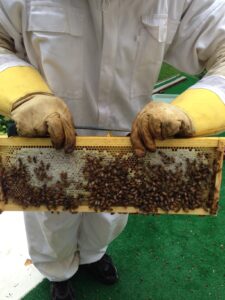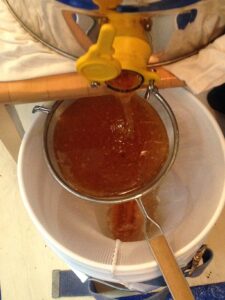As local as it gets: Como Lake Honey
By Jeanne Rogge Steele
Q: What is made out of plastic, filled to the brim with liquid gold, and looks like a friendly little bear with a rendition of the Como Pavilion glued to its chest?
A: An 8 ounce container of Como Lake Honey, the most local, raw honey around – produced by honeybees that live on a rooftop right across from the lake. The honey is Dean Anderson’s gift to the Como community which he and his family have called home for the past 22 years.
“It’s all about the habitat,” says Anderson, who lives on Como Blvd. East between Rose and Maryland Ave. “Almost all of the nectar that goes into that honey comes from the trees, plants and flowers that grow around the lake and park, and in the gardens of Como neighbors.” Although he credits his wife, Dorie, and sons Trevor, Reid and Ross for supporting his hobby, it’s clearly Anderson himself who is the prime mover behind Como Lake Honey. Referred to by some as the Como Honey Guy, he waxes poetic about the Como Park habitat that nourishes his bees.
The dandelions come first, he says. Then, the flowering fruit trees – the crabapples, plums, cherry and apple trees. Soon it’s a steady stream of basswood, clover, coneflowers, thistle, honeysuckle, milkweed and more. “You can see the tens of thousands of blossoms that attract them if you regularly walk around the lake or through the park. If you look closely, you’ll see my honeybees.”
Anderson got interested in keeping bees almost a decade ago when he spotted a notice for an “Intro to Bee-keeping” class while paging through a Commed brochure. The class piqued his interest. He took a more advanced course that spring, and he was hooked. “I can do this!”
One of the first things Anderson did was join the Minnesota Hobby Beekeepers Association, which meets monthly on the University of Minnesota’s St. Paul Campus, also home to the university’s Bee Lab. He also took a class at the Minnesota Landscape Arboretum.
Not terribly expensive or high tech, beekeeping requires a permit from the city to keep bees, a safe place to locate the hives, the proper equipment, protective clothing, and BEES. They can be ordered online and picked up from a local supplier in April. A 3-pound package contains one queen bee and about 10,000 female worker bees. A few male drones round out the mix. The same demographics hold true in a hive, Anderson says: One queen, thousands of female worker bees, and a handful of male drones.
Anderson’s hives – he likes to keep three — sit 12 feet above the ground on the flat roof over his ground-level sunroom. There, they don’t bother anybody, he says, but they do need to be managed. Not native to North America, honeybees live in colonies and don’t hibernate. They spend summer days flying from flower to flower, rubbing off pollen to take home to the hive. In winter, they “cluster,” piling one atop the other in a tight mass to generate heat and get at the honey they have produced and stored to feed themselves and keep their queen warm. Worker bees have short life spans – 42 days on average in Minnesota. Queen bees, however, can live 2 – 3 years and lay as many as 1,000 eggs per day in spring and summer. There is just one queen per colony. Once a queen’s egg production begins to slow down, she is replaced – stung to death either by her own offspring or a new queen. But that’s a story for another day.
Harvesting the honey produced by his bees is undoubtedly the hardest part of Anderson’s job. Basically, he must steal it from the bees. As summer progresses, beekeepers add boxes containing 9-10 frames to their hives, giving their bees more and more room to grow in population and store honey. Anderson says he likes to leave about 100 pounds of honey in the hive to get his bees through the winter. Getting whatever is leftover out of the hive and into containers is a two-weekend, “sticky mess” of a job, he says, acknowledging that “there’s no way [he] could do it without Dorie’s help and patience.” Bees get into the house. Occasionally he gets stung. Honey gets on the floor.
However, it’s all worth it, Anderson says, if, come fall, his bees have made enough honey to share. That’s when he sets up a table in front of his house, and neighbors stop by to learn about Como Lake Honey and tell him they have spotted his bees in their pollinator-friendly gardens. “Location, location, location!” he says. “That’s why it tastes so good.”
Jeanne Steele is a Minnesota native who likes living near the Lake just as much as Anderson’s bees.




